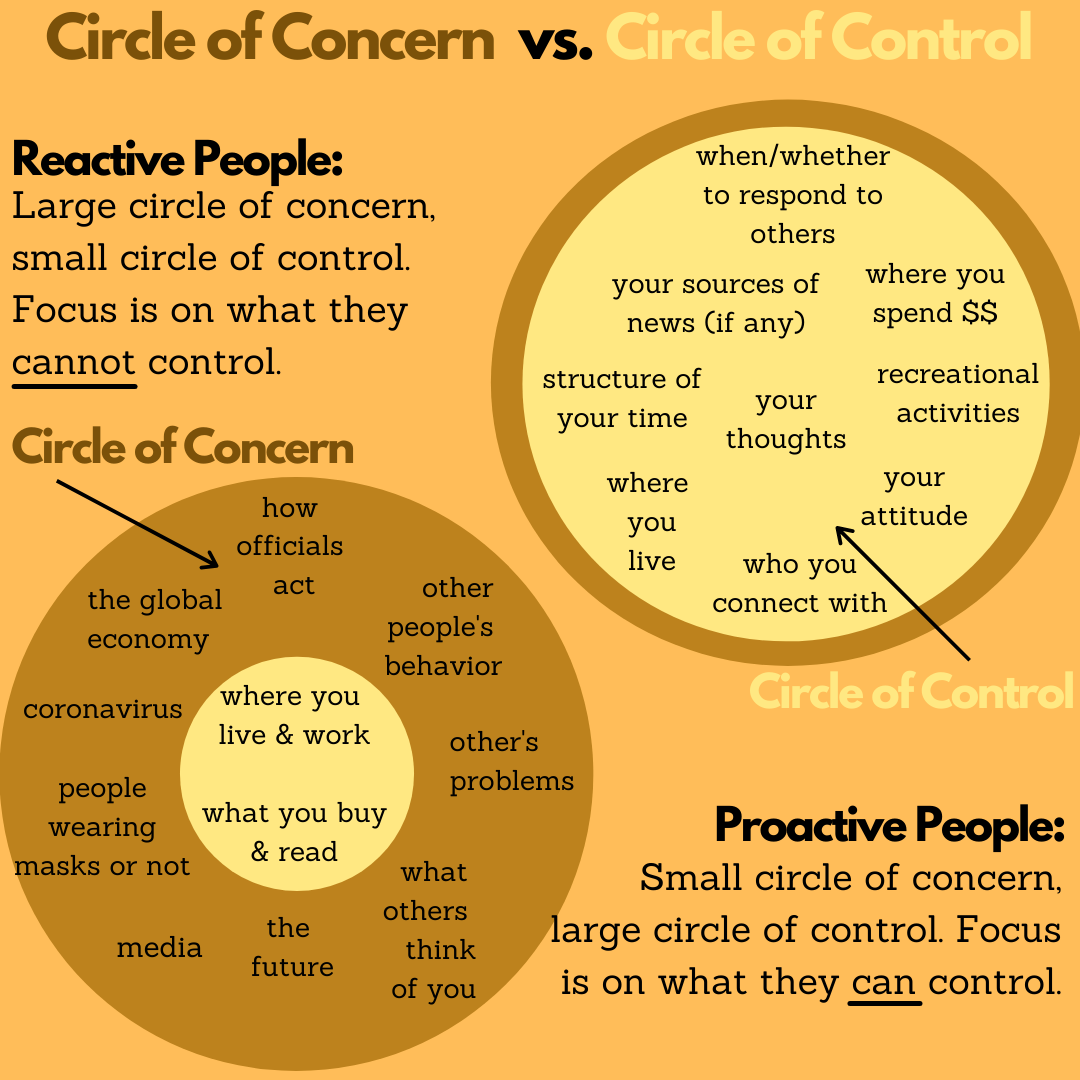There’s a lot going on right now that’s out of our control. This has caused many of us stress and anxiety. There are always things outside our control, but now it’s happening on a grand scale and it’s happening to everyone.

There is something you can control though, and that’s your focus. Where you put your attention matters. This article will show you how to shift your attention away from things you cannot control and onto things you can control. This will ease tension and anxiety and give you more control over your life. It will also likely increase your energy as you start to affect your life in ways that matter.
Covey’s Circles of Concern and Control.
The graphic depicted here, inspired by Stephen Covey, shows Circles of Concern (brown circle) and Control (yellow circle). These illustrate the difference between what we can and cannot control. Covey’s use of language is helpful here. He acknowledges that we have every right to be concerned about the things in the brown circle. He also shows that the things in the circles don’t necessarily change when we shift our focus. It’s how much energy we put into them that changes.
Reactive vs. proactive people.
Reactive people have large Circles of Concern and small Circles of Control. They spend a lot of time and energy reacting to issues they can’t control and very little where they can actually make a difference. Energy they could be spending on things they can control is wasted on areas where they have no control. This increases anxiety. Proactive people have a small Circle of Concern and a large Circle of Control. They spend a lot of time and energy focused on issues that are within their control.
Things in the Circle of Concern are people, places and things other than yourself. When we keep our focus here, we prevent ourselves from putting our attention where it can actually do some good – in the Circle of Control. If you focus on the global economy, the future, etc., then you’re being reactive rather than proactive. That means you’re not in charge of your life. This usually comes with lots of anxiety, stress and tension. It often prevents you from doing things that are within your control! It’s tough to live a life in which you feel you have no impact.
You don’t have to live like that!
Focus on the yellow circle to ease anxiety, tension and stress.
The answer is not “If only things went my way.” It’s actually, “stop focusing on that stuff.” Shift the spotlight from the Circle of Concern to the Circle of Control. This will give you more control over your life, not just the perception of more control.
Your Circle of Control includes your thoughts, attitudes, behaviors and beliefs. You get to decide what you think and think about, what your attitudes will be, how you’re going to act and what you believe.
An example might be deciding when/whether you’re going to respond to others who contact you. If you’re getting pissed off because somebody won’t stop texting or calling you, that’s on you. Other people’s behavior is in your Circle of Concern, not your Circle of Control. Your thoughts about their behavior are in your Circle of Control, as is your behavior. Maybe you’re thinking, “They shouldn’t call me so often.” If so, it’s that thought that’s causing you the problem, not them calling you so often. You could silence your phone or not answer. This may not feel like a choice (especially if it’s a family member), but it is. It’s your choice.
There will be consequences to your actions, to be sure. But you get to decide what those consequences mean to you. If it would be 100X worse for you to avoid calls than it would be to pick up the phone, then you can choose to do that. Understand though, that that’s a choice you’re making. It’s not the other person’s problem or responsibility. It’s yours. And your reaction is yours as well. It may not feel like a choice, but it is.
We train people how to treat us.
This shift may be a difficult journey, but remember – we train people how to treat us. You can retrain them. And when you do, you’re moving from being reactive to proactive.
Feeling like we have choices about things is liberating compared to feeling like we have to do something. It makes us feel like we’re in charge of our lives. In fact, you are in charge of your life. That’s what this is all about!
What you focus on gets magnified.
Seek and ye shall find. If you are always looking for disaster, you’re going to find it. If you’re always looking for blessings, you’re going to find them.
You get to decide where to focus your attention. Will it be on your Circle of Concern or your Circle of Control? Are you going to be reactive and probably live with anxiety, tension and stress? Or are you going to be proactive and focus on the things that you can control – like your attitudes, behaviors, thoughts and how you spend your time. This will increase your sense of control. You won’t be wasting time and energy on things you cannot control. You’ll be exerting the most effort on the areas where you do have control.
If you’re still unclear about what you can and cannot control. Try this: draw your own circles of Concern and Control. Include the things that are causing you anxiety and stress. Then compare what you have in your circles to what’s in the circles pictured here. Adjust what’s in your circles. Then adjust what you focus on.

